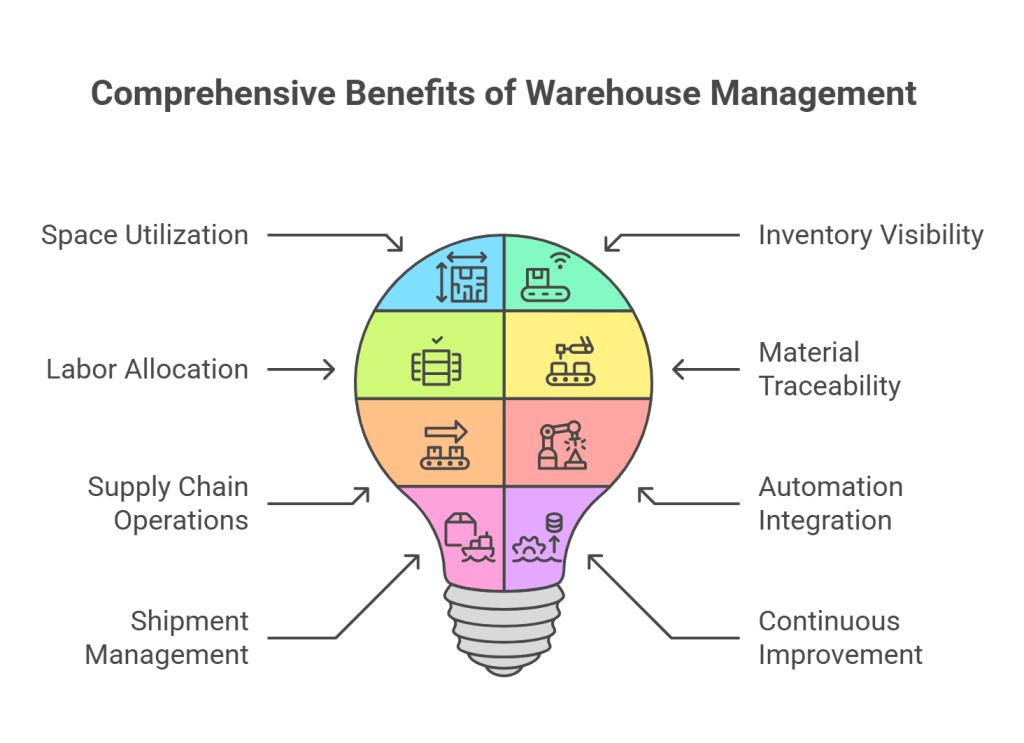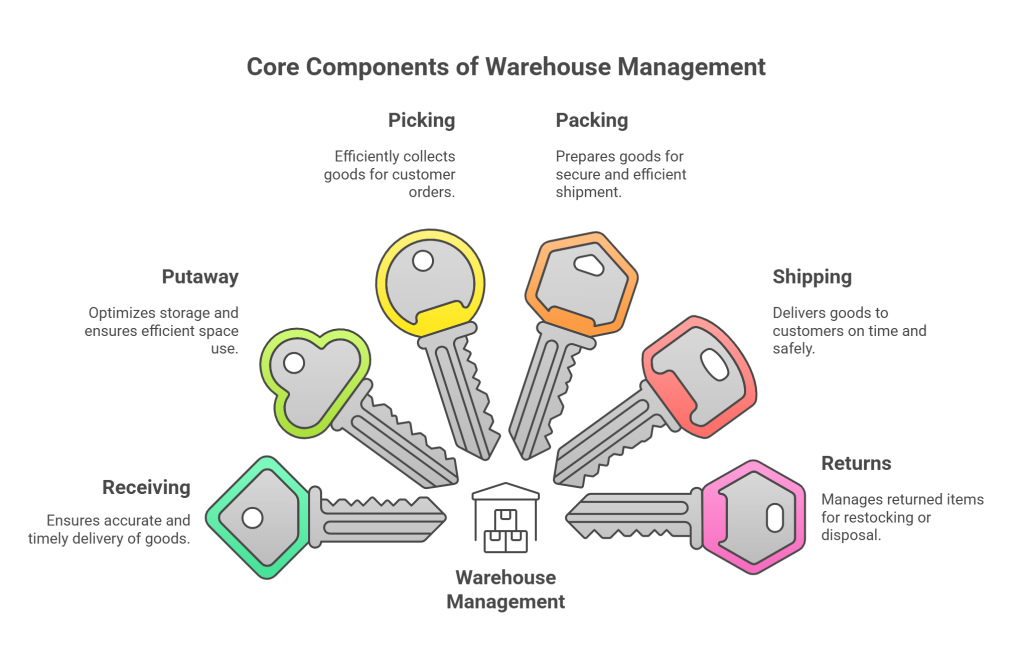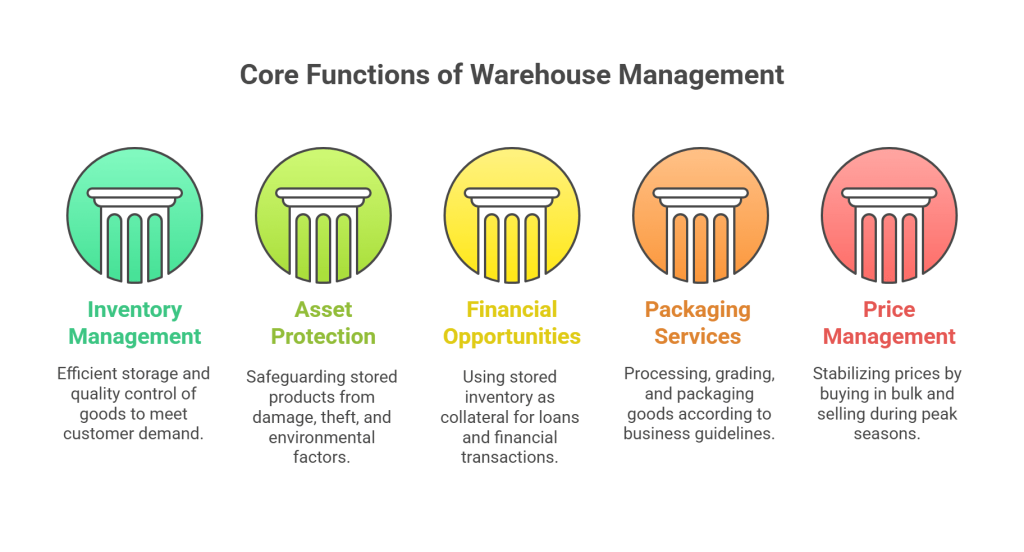
As small businesses experience rapid growth, managing inventory and fulfilling orders can become complex. This complexity often signals the need for a warehouse management provider. These providers optimize inventory storage and streamline packaging and shipping processes, ensuring fast order fulfilment.
In e-commerce, storing inventory until orders are placed becomes challenging as the business expands. Warehousing solutions become essential to manage logistics efficiently, enabling timely shipping from multiple locations to customers worldwide.
In this piece, we’ll explore the benefits of warehousing services, their integration with e-commerce operations, and essential considerations when selecting a warehousing solution.
Defining Warehouse Management
Warehouse management is about keeping everything in your warehouse running smoothly. Warehouse management has several elements and covers inventory, organization, order processing, staff management, and shipping coordination. Its goal is to make operations efficient and cost-effective without compromising quality.
So, you’re arranging the warehouse layout, handling equipment, dealing with incoming stock, packing orders, and tracking performance. Most fast-growing retailers use automation tools like warehouse management systems, and it has several benefits as well.
Benefits of Warehouse House Management:

1. Enhanced Space Utilization and Cost Reductions
Warehouse management systems (WMS) optimize warehouse layouts, minimizing wasted floor space and reducing operational costs. WMS solutions analyze space usage, optimizing floor plans to reduce material movement and placement time, thereby cutting operating expenses.
2. Improved Inventory Visibility
WMS provides real-time inventory visibility, allowing companies to accurately assess stock levels and prevent backorders. Automation tools like scanning and RFID enhance location tracking, reducing instances of forgotten or misplaced inventory.
3. Efficient Labor Allocation
By considering worker skills, proximity, and available tasks, WMS optimizes labor allocation, reducing travel time within the warehouse and improving overall efficiency. Labor forecasting and task assignment functionalities streamline scheduling and increase workforce productivity.
4. Enhanced Material Traceability
WMS enables easy material tracing of inventory materials using lot, batch, and serial numbering, ensuring full traceability throughout the supply chain. This capability reduces redundancy, supports accurate inventory planning, and provides valuable data for maintenance or recall scenarios.
5. Streamlined Supply Chain Operations
Warehouse management systems optimize internal warehouse processes, leading to operational efficiencies and cost reductions. Fast and accurate shipments improve partner relationships and enable better planning for suppliers, shippers, and customers.
6. Internal Automation Integration
WMS serves as a foundation for implementing additional automation technologies within the warehouse, such as mobile devices and robotics. Automation streamlines processes increases scalability, and ensures data accuracy, supporting ongoing improvement in operations.
7. Effective Shipment Management and Customer Service
WMS enables efficient Shipment management inbound and outbound planning, optimizing inventory movements and scheduling to meet customer demands. Advanced picking and packing options improve order cycle times, while enhanced tracking capabilities provide customers with timely shipping notifications, enhancing overall customer satisfaction.
8. Continuous Improvement
Warehouse management systems facilitate ongoing improvements by allowing phased implementations and incorporating new features over time. Cloud-based solutions offer instant updates, reducing the need for extensive IT support and enabling warehouses to stay efficient and adaptable to changing business needs.
Key Features of Warehouse Management

1. Receiving
This involves controlling the delivery of products to the warehouse, ensuring the correct quantity and quality are received at the right time. Tasks include placing purchase orders, preparing warehouse space, unloading, verification, and updating the database. Automated dimensions and dock schedulers help streamline these processes.
2. Putaway
Delivering goods to the optimal location within the warehouse is crucial. Proper identification of each stock-keeping unit (SKU) and consideration of storage conditions ensure efficient use of space and safety of goods. Techniques like slotting and space management, along with warehouse design, play vital roles in optimization.
3. Picking
Collecting goods according to customer orders is a critical and resource-intensive process. Mobile scanning devices, voice systems, and picking methodologies like cluster picking or wave picking help reduce time and errors during picking operations.
4. Packing
This involves assembling ordered items, checking quality, and preparing products for shipment. Accurate order data and knowledge of packing material requirements are essential. Automated wrappers can further expedite the packing process while reducing material usage.
5. Shipping
Dispatching goods to customers in a timely and secure manner requires effective scheduling, labor management, and tracking systems. Ensuring orders are delivered safely and on time is crucial for customer satisfaction.
6. Returns
Managing returns and refunds is an inevitable aspect of business, particularly in e-commerce. Proper identification, sorting, and processing of returned items are necessary for restocking, repair, disposal, or return to the manufacturer, ensuring efficient handling of returns.
Functions of Warehouse Management

1. Inventory Management
Warehouse management involves efficiently storing physical goods to meet customer demand and store items awaiting sale. Quality control services are often integrated to ensure stored goods meet standards.
2. Asset Protection
Warehouses are designed to safeguard stored products from elements like fire, damage, and theft. These protective features ensure items are maintained in optimal condition for order fulfilment.
3. Financial Opportunities
Stored inventory can serve as collateral for loans, either through warehouse keepers or financial institutions issuing loans based on warehouse receipts.
4. Packaging Services
Many warehouses offer services such as processing, grading, and packaging of items. Operations are streamlined to handle goods according to specified guidelines set by business owners.
5. Price Management
Warehouse management contributes to price stabilization by enabling businesses to capitalize on fluctuations in commodity prices. By purchasing in bulk during off-peak periods and storing for later sale during peak seasons, warehouses assist in managing market price fluctuations.
Conclusion
In conclusion, effective warehouse management is essential for businesses to thrive in today’s competitive landscape. By optimizing inventory, streamlining processes, and enhancing visibility, companies can meet customer demands efficiently while minimizing costs.
With the right warehouse management solution, businesses can achieve enhanced space utilization, improved labor allocation, and streamlined supply chain operations. Qodenext provides advanced warehouse management solutions tailored to diverse business needs, ensuring seamless operations and customer satisfaction.
FAQ: Warehouse Management: Definition, Benefits, Features, and More!
1. What are the 4 types of warehouse management?
The four types of warehouse management are labor management, inventory management, slotting optimization, and transportation management.
2. What is the most important thing in warehouse management?
The most important thing in warehouse management is optimizing efficiency to ensure smooth operations, timely order fulfilment, and cost-effective inventory management.
3. What is warehouse efficiency?
Warehouse efficiency refers to the ability to maximize productivity and minimize waste in warehouse operations, including processes such as receiving, storage, picking, packing, and shipping.
4. What is the KPI in warehouse management?
Key Performance Indicators (KPIs) in warehouse management measure various aspects of performance, including order accuracy, inventory turnover, picking and packing efficiency, on-time delivery, and labor productivity.
5. What is SCM in a warehouse?
SCM (Supply Chain Management) in a warehouse involves the integration of processes to optimize the flow of goods, information, and finances from suppliers to customers, ensuring efficient warehouse operations within the broader supply chain.
6. What is a Warehouse Management System (WMS)?
A Warehouse Management System (WMS) is a software solution that helps control and manage day-to-day warehouse operations. It automates tasks such as inventory tracking, order picking, packing, and shipping, ensuring accuracy and operational efficiency.
7. How does warehouse management support e-commerce businesses?
Warehouse management supports e-commerce by enabling fast and accurate order fulfillment, real-time inventory tracking, efficient returns handling, and integration with online platforms. This ensures timely deliveries and enhances customer satisfaction.
8. What role does automation play in warehouse management?
Automation plays a key role in improving warehouse efficiency by reducing manual labor, minimizing errors, and accelerating processes like picking, packing, and inventory updates. Tools include robotics, conveyor systems, RFID scanning, and automated storage systems.
9. Can small businesses benefit from warehouse management systems?
Yes, small businesses can greatly benefit from WMS by gaining better control over inventory, reducing fulfillment errors, and improving customer service. Cloud-based or scalable WMS solutions are ideal for small businesses looking for affordable and flexible options.







